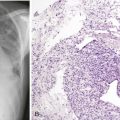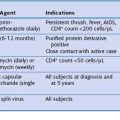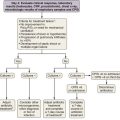Chapter 67 Lung Cancer
Treatment
1. Curative therapy should be used whenever feasible.
2. Curative therapy must address all grossly detectable disease, as well as reduce the likelihood of death from occult metastatic disease.
3. Toxicity or risk from treatment can outweigh the benefit when the patient is burdened by significant comorbid illness or when the risk of distant metastasis is extremely low.
Two competing principles are often cited as well: the treatment of lung cancer is strictly dependent on the stage of the disease, but accurate staging is often not possible before treatment (surgery) is rendered. This apparent paradox is resolved by recognizing that the first step in evaluating a patient with suspected lung cancer is the simultaneous determination of (a) whether cancer is the likely diagnosis on clinical grounds, (b) if cancer, whether it appears surgically resectable for cure, and (c) if “yes” to the first two questions, whether the patient can tolerate the required degree of surgical resection (see Chapter 66).
Non–Small Cell Lung Cancer
Stage III Lung Cancer
The current standard of care for adequately staged patients with stage III NSCLC depends greatly on the patient’s comorbid conditions and overall health status. The most commonly used global assessment of these factors in clinical practice is performance status (Box 67-1). Standard treatments for those with good to excellent Eastern Cooperative Oncology Group performance status (ECOG 0-1) are chemoradiation therapy administered concurrently. For those with less favorable performance status (ECOG 2), sequential chemotherapy followed by radiation therapy is still possible. The rationale for this is that concurrent therapy provides a survival benefit compared with sequential therapy, but at the cost of a greater likelihood of toxicity. Pulmonary toxicity is similar whether treatment is concurrent or sequential, but the occurrence of esophagitis (which can be severe) is more common with concurrent chemoradiation therapy than with sequential therapy. Those with marginal performance status (ECOG 2) may tolerate sequential therapy but are poor candidates for concurrent chemotherapy with thoracic radiation. In general, patients with ECOG performance status 3 or worse are best treated with a palliative approach focused on managing symptoms (i.e., best supportive care). This can include local radiotherapy to minimize complications such as airway obstruction, chest wall pain, or hemoptysis. Patients with poor performance status do not benefit from systemic chemotherapy and are more likely to experience severe toxicity.
Box 67-1
ECOG Performance Status Scale*
0: Asymptomatic (fully active, able to carry on all activity without restriction)
1: Symptomatic but completely ambulatory (restricted in physically strenuous activity but ambulatory and able to carry out work of a light or sedentary nature; e.g., light housework, office work)
2: Symptomatic, <50% time in bed or chair during the day (ambulatory and capable of all self-care but unable to carry out any work activities)
3: Symptomatic, >50% of time spent in bed or chair, but not bedbound (capable of only limited self-care)
4: Bedbound (completely disabled; cannot carry on any self-care; totally confined to bed or chair)
From Oken MM et al: Toxicity and response criteria of the Eastern Cooperative Oncology Group, Am J Clin Oncol 5:649–655, 1982.
The choice of chemotherapy for stage III NSCLC includes a platinum-based drug (cisplatin or carboplatinum) in combination with one other agent with demonstrated activity in NSCLC (Table 67-1). Gemcitabine, a drug with good single-agent activity often used in adjuvant settings or metastatic disease, is not typically used in combination with radiation because of its tendency to sensitize even normal tissue to the toxic effects of ionizing radiation. The dose of radiation for patients treated concurrently is generally left up to the radiotherapist, but doses used in this setting are lower than those used for primary treatment of early-stage, medically unresectable patients. Most trials delivered radiation doses of about 60 Gy. With better techniques that can limit damage to normal tissues, radiation oncologists are seeking ways to escalate the dose of radiation to increase the rate of cure. PET scans have been used in a course of radiation to adjust the port to a shrinking tumor, permitting a greater dose to metabolically active tumor (and consequently less to healthy tissue), as defined by the PET scan. These ongoing studies are likely to impact on the future treatment of NSCLC.
Table 67-1 Common Chemotherapy Regimens for Non–Small Cell (NSCLC) and Small Cell Lung Cancer
| Drug | Most Common Toxicity | Comment |
|---|---|---|
| Stage III NSCLC | ||
| Cisplatin or Carboplatin Plus |
Nephrotoxicity Myelosuppression |
Two cycles of combination chemotherapy are usually used concurrently with radiation. Patients with marginal performance status usually receive sequential therapy. |
| Paclitaxel or | Neuropathy, allergic reactions, myelosuppression | |
| Etoposide | Myelosuppression | |
| Stage IV NSCLC* | ||
| Cisplatin or Carboplatin Plus |
Nephrotoxicity Myelosuppression |
Goal: give three or four cycles of two-drug combination. Can be combined with bevacizumab |
| Any of agents used for stage III disease or | Myelosuppression | |
| Gemcitabine or | Myelosuppression | Usually not used in combination with radiotherapy, due to potent radiosensitizing effects and greater incidence of normal tissue toxicity |
| Pemetrexed | Myelosuppression, mucositis, nausea | Approved only for non–squamous cell lung cancer |
| Small Cell Lung Cancer | ||
| Cisplatin or Carboplatin Plus |
Nephrotoxicity Myelosuppression |
Goal: give four to six cycles of two-drug combination. |
| Etoposide or | Myelosuppression | |
| Irinotecan | Diarrhea, myelosuppression | |
| Second-Line Drugs | ||
| Docetaxel | Hepatotoxicity, neutropenia, thrombocytopenia | Usually used as single agent in patients who relapsed after standard therapy |
| Gefitinib† or Erlotinib | Skin rash | Response is better in patients with tumors bearing activating-EGFR mutations. |
* Patients with activating mutations in epidermal growth factor receptor (EGFR) have better survival when treated with first-line EGFR–tyrosine kinase inhibitors.
Stage IV Lung Cancer
Despite advances in treatment of advanced NSCLC, therapeutic nihilism has remained prevalent among clinicians, generally more than in other types of solid-organ tumors. A metaanalysis of trials with patients randomly assigned to “best supportive care” versus chemotherapy, including a cisplatin-based regimen, showed a survival benefit in the chemotherapy group. The active chemotherapy group had a reduction in the risk of death of 27% and an absolute improvement in survival of 10% at 1 year. In the 1990s, many promising new chemotherapeutic agents (paclitaxel, docetaxel, irinotecan, vinorelbine, gemcitabine, pemetrexed), each with single-agent activity in advanced disease, were developed for and then used in patients who had stage IV NSCLC. Numerous trials evaluated combinations of one or more of these newer agents with a platinum compound (cisplatin or carboplatinum; see Table 67-1). No one combination of drugs is superior. However, with use of platinum-based combinations, median survival gradually increased to 8 to 9 months, with 1-year survival of 30% to 35%. This compares favorably with untreated patients with stage IV NSCLC, who have median survival of 3 to 4 months, with 1-year survival of approximately 15%. Although no data exist to define the optimum combination of chemotherapeutic agents, newer data are leading to increasingly individualized approaches to care.
Small Cell Lung Cancer
Although the updated (7th edition) staging system for lung cancer (see Chapter 66) has been validated in SCLC as well as NSCLC, the treatment of SCLC has traditionally focused on defining limited-stage versus extensive-stage SCLC. Limited-stage SCLC, the purview of the radiation oncologist, is defined by a tumor burden that can be encompassed within a single radiotherapy port with acceptable risk of toxicity. This applies to approximately 30% of patients with SCLC, in whom the addition of thoracic radiotherapy to systemic chemotherapy increases the likelihood of long-term survival. Approximately 20% of patients with limited-stage disease reach 5-year survival. For the remaining 70% of SCLC patients, with extensive-stage disease, the recommended treatment is systemic chemotherapy alone, and radiotherapy in these patients is limited to treating CNS metastases or symptomatic skeletal metastases.
Paraneoplastic Syndromes and Other Common Complications
Paraneoplastic syndromes are defined as systemic or localized effects of tumors unrelated to physical effects of the tumor mass. These syndromes can be divided into those caused by humoral factors produced by the tumor (hormones or other bioactive products) and those caused by immune response to the tumor in the form of autoantibodies. Most of the latter occur in the context of SCLC and result from a variety of antineuronal antibodies. Paraneoplastic syndromes can affect the skin, CNS and peripheral nervous system, vascular system, heart, kidneys, marrow, and muscular or skeletal system (Table 67-2).
Table 67-2 Paraneoplastic Syndromes: Manifestations of Lung Cancer and Treatment
| Syndrome | Manifestations | Treatment |
|---|---|---|
| Syndromes Caused by Production of Bioactive Hormones by Tumor | ||
| SIADH | Hyponatremia | Water restriction Demeclocycline |
| Cushing’s syndrome | Hypertension, glucose intolerance, electrolyte abnormalities, muscle weakness, weight loss, hirsutism, osteoporosis | Often improves with treatment of the cancer; can use ketoconazole, metyrapone, or mitotane |
| Hypercalcemia | Weakness, mental status changes, nausea | Treatment of the cancer Intravenous hydration Bisphosphonates, calcitonin |
| Syndromes Caused by Humoral Immune Responses to Tumor | ||
| Lambert-Eaton myasthenic syndrome (LEMS)* | Weakness, muscle fatigue, often affects large muscle groups with preserved small muscle function; improvement with repetitive use | Usually improves with treatment of the cancer; can use plasma exchange or agents that increase synaptic depolarization (3,4-diaminopyridine) with or without pyridostigmine |
| Cerebellar degeneration† | Dizziness, nausea, vertigo, ataxia, and sometimes diplopia; onset can be abrupt | Symptoms often irreversible because of Purkinje cell loss |
| Limbic encephalitis‡ | Cognitive impairment, mood changes, disordered perception, and sleep disturbances | Treatment may result in improvement; immune suppression may help if tumor is also treated. |
SIADH, syndrome of inappropriate (secretion of) antidiuretic hormone.
* Antibody to voltage-gated calcium channel.
† Anti-Yo antibodies, or Purkinje cell antibody type 1 (PCA-1).
‡ Anti-Hu antibodies or “antineuronal nuclear antibodies” (ANNA-1).
Albain KS, Rusch VW, Crowley JJ, et al. Concurrent cisplatin/etoposide plus chest radiotherapy followed by surgery for stages IIIA (N2) and IIIB non-small-cell lung cancer: mature results of Southwest Oncology Group Phase II study 8805. J Clin Oncol. 1995;13:1880–1892.
American College of Chest Physicians Diagnosis and management of lung cancer: ACCP guidelines (2nd edition). Chest. 2007;132(suppl 3). http://chestjournal.chestpubs.org/content/132/3_suppl.toc.
Dillman RO, Seagren SL, Propert KJ, et al. A randomized trial of induction chemotherapy plus high-dose radiation versus radiation alone in stage III non-small-cell lung cancer. N Engl J Med. 1990;323:940–945.
Furuse K, Fukuoka M, Kawahara M, et al. Phase III study of concurrent versus sequential thoracic radiotherapy in combination with mitomycin, vindesine, and cisplatin in unresectable stage III non–small-cell lung cancer. J Clin Oncol. 1999;17:2692–2699.
Mok TS, Wu YL, Thongprasert S, et al. Gefitinib or carboplatin-paclitaxel in pulmonary adenocarcinoma. N Engl J Med. 2009;361:947–957.
Paez JG, Jänne PA, Lee JC, et al. EGFR mutations in lung cancer: correlation with clinical response to gefitinib therapy. Science. 2004;304:1497–1500.
Soda M, Choi YL, Enomoto M, et al. Identification of the transforming EML4-ALK fusion gene in non-small-cell lung cancer. Nature. 2007;448:561–566.
Temel JS, Greer JA, Muzikansky A, et al. Early palliative care for patients with metastatic non-small-cell lung cancer. N Engl J Med. 2010;363:733–742.







